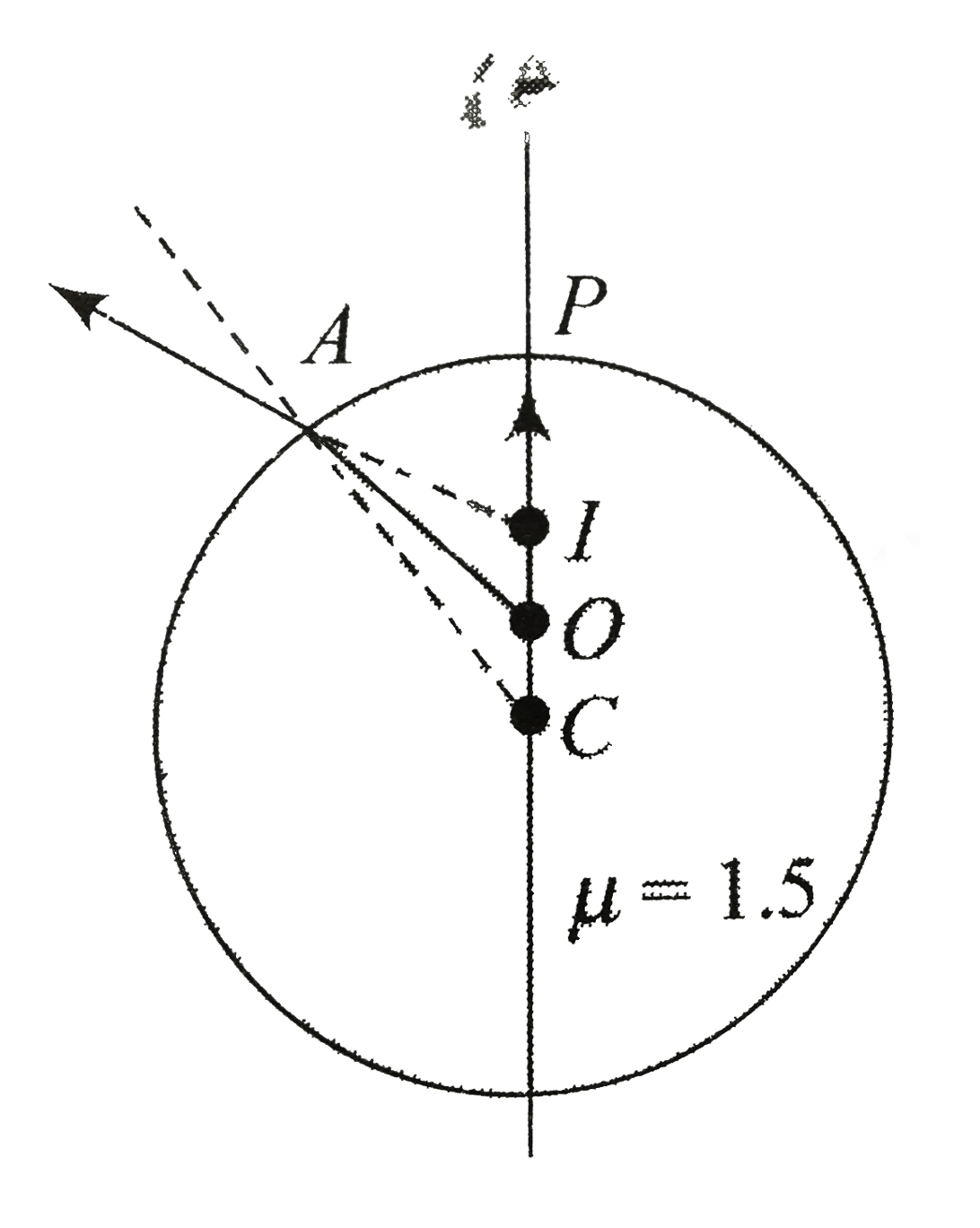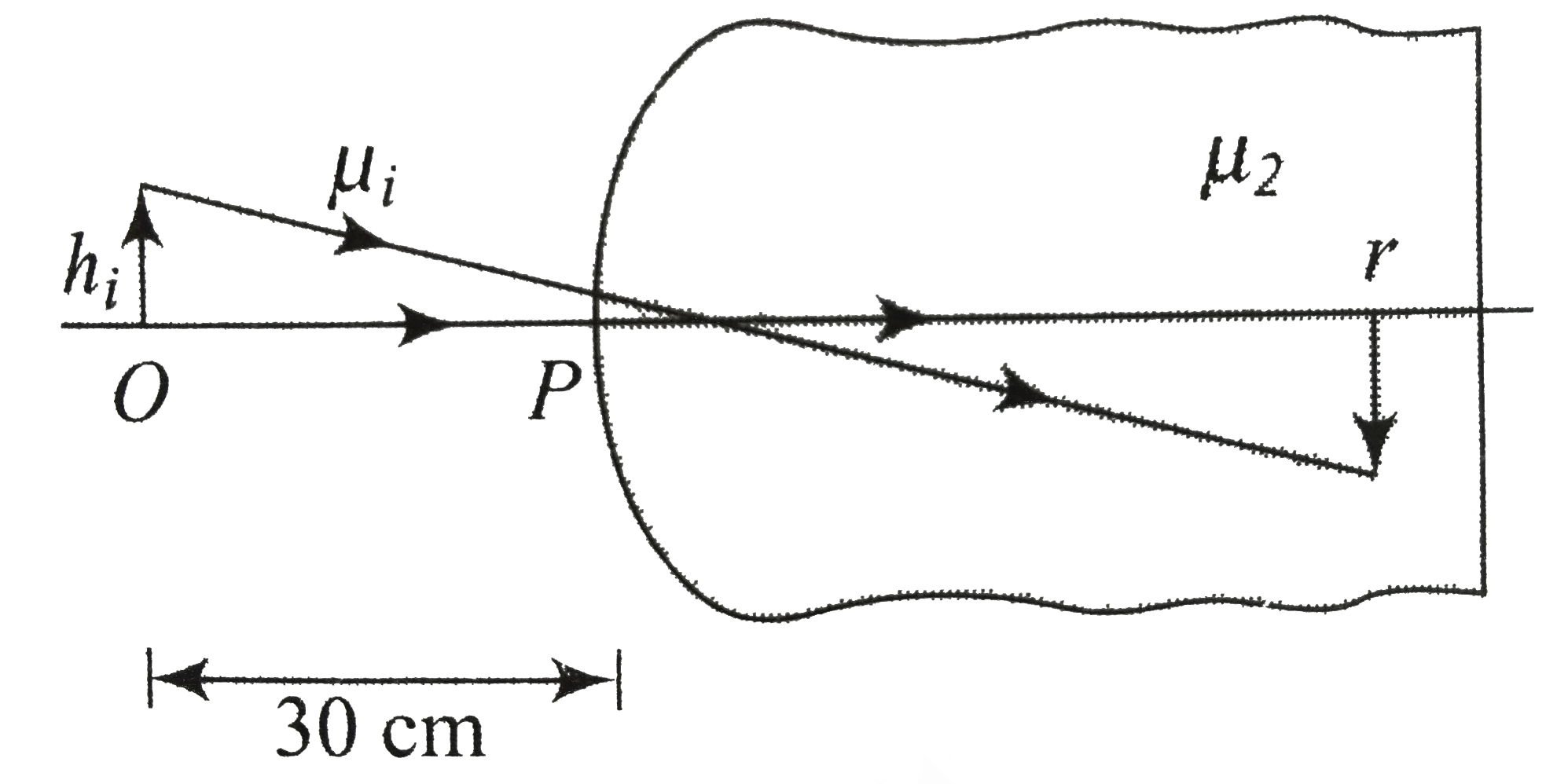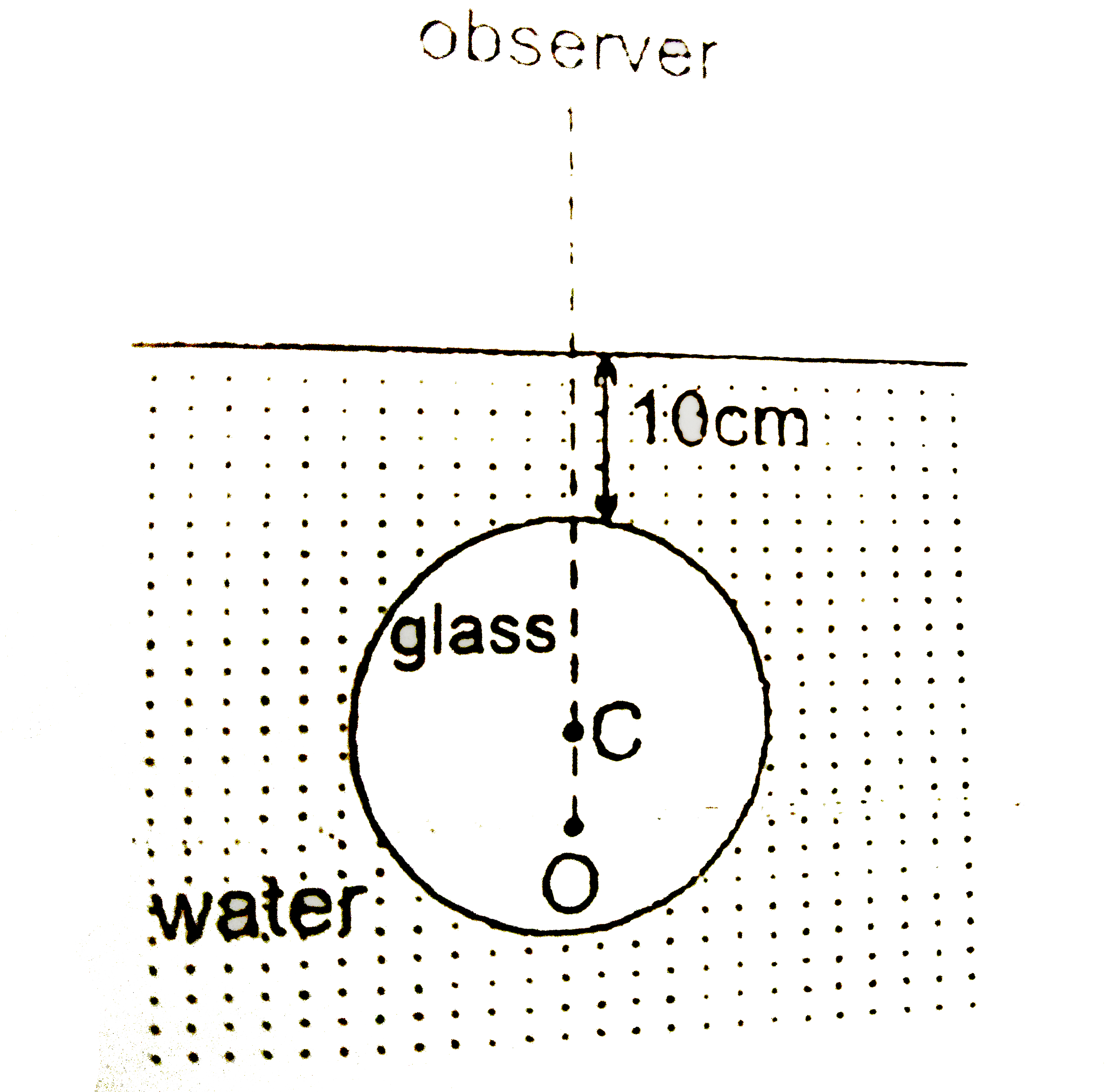A small object is embedded in a glass sphere (mu =1.5) of radius 5.0 cm at a distance 1.5 cm left to the centre. Locate the image of the object as seen by an observer standing (a) to the left of the sphere and (b) to the right of the sphere.
The correct Answer is:A, B, C
To solve the problem of locating the image of a small object embedded in a glass sphere, we will follow these steps:
Step 1: Understand the Setup
- We have a glass sphere with a refractive index (μ) of 1.5 and a radius (R) of 5.0 cm.
- The object is located 1.5 cm to the left of the center of the sphere.
Step 2: Determine Object Distance
- The center of the sphere is taken as the origin (0 cm).
- The object is located at -1.5 cm (1.5 cm to the left of the center).
- The radius of the sphere is 5 cm, so the object distance (u) from the surface of the sphere is:
u=R−1.5=5.0−1.5=3.5 cm
Since the object is to the left of the center, we take u as negative:
u=−3.5 cm
Step 3: Apply the Refraction Formula
- We will use the formula for refraction at a spherical surface:
μ1v−μ2u=μ1−μ2R
Here,
- μ1 (air) = 1,
- μ2 (glass) = 1.5,
- R = -5 cm (since the surface is bulging inwards).
Step 4: Substitute Values for the Left Observer
- Substitute the values into the formula:
1v−1.5−3.5=1−1.5−5
Simplifying gives:
1v+1.53.5=−0.5−5
1v+37=110
Step 5: Solve for v
- Rearranging gives:
1v=110−37
Finding a common denominator (70):
1v=770−3070=−2370
Thus,
v=−7023≈−3.04 cm
- This indicates that the image is formed 3.04 cm to the left of the surface of the sphere.
Step 6: Repeat for the Right Observer
- For the observer on the right side, the object distance will be:
u=5+1.5=6.5 cm(still negative)
So,
u=−6.5 cm
Step 7: Substitute Values for the Right Observer
- Again using the refraction formula:
1v−1.5−6.5=1−1.5−5
Simplifying gives:
1v+1.56.5=−0.5−5
1v+313=110
Step 8: Solve for v Again
- Rearranging gives:
1v=110−313
Finding a common denominator (130):
1v=13130−30130=−17130
Thus,
v=−13017≈−7.65 cm
- This indicates that the image is formed 7.65 cm to the left of the surface of the sphere.
Final Results
- (a) The image as seen by an observer to the left of the sphere is approximately 3.04 cm to the left of the surface.
- (b) The image as seen by an observer to the right of the sphere is approximately 7.65 cm to the left of the surface.
- We have a glass sphere with a refractive index (μ) of 1.5 and a radius (R) of 5.0 cm.
- The object is located 1.5 cm to the left of the center of the sphere.
- The center of the sphere is taken as the origin (0 cm).
- The object is located at -1.5 cm (1.5 cm to the left of the center).
- The radius of the sphere is 5 cm, so the object distance (u) from the surface of the sphere is:
u=R−1.5=5.0−1.5=3.5 cm
Since the object is to the left of the center, we take u as negative:
u=−3.5 cm
- We will use the formula for refraction at a spherical surface:
μ1v−μ2u=μ1−μ2R
Here,
- μ1 (air) = 1,
- μ2 (glass) = 1.5,
- R = -5 cm (since the surface is bulging inwards).
- Substitute the values into the formula:
1v−1.5−3.5=1−1.5−5
Simplifying gives:
1v+1.53.5=−0.5−5
1v+37=110
- Rearranging gives:
1v=110−37
Finding a common denominator (70):
1v=770−3070=−2370
Thus,
v=−7023≈−3.04 cm
- This indicates that the image is formed 3.04 cm to the left of the surface of the sphere.
- For the observer on the right side, the object distance will be:
u=5+1.5=6.5 cm(still negative)
So,
u=−6.5 cm
- Again using the refraction formula:
1v−1.5−6.5=1−1.5−5
Simplifying gives:
1v+1.56.5=−0.5−5
1v+313=110
- Rearranging gives:
1v=110−313
Finding a common denominator (130):
1v=13130−30130=−17130
Thus,
v=−13017≈−7.65 cm
- This indicates that the image is formed 7.65 cm to the left of the surface of the sphere.
- (a) The image as seen by an observer to the left of the sphere is approximately 3.04 cm to the left of the surface.
- (b) The image as seen by an observer to the right of the sphere is approximately 7.65 cm to the left of the surface.
Topper's Solved these Questions
- BOOK - HC VERMA ENGLISHCHAPTER - GEOMETRICAL OPTICSEXERCISE - EXAMPLE9videos
GEOMETRICAL OPTICS
- BOOK - HC VERMA ENGLISHCHAPTER - GEOMETRICAL OPTICSEXERCISE - Question For short Answer18videos
GEOMETRICAL OPTICS
- BOOK - HC VERMA ENGLISHCHAPTER - GEOMETRICAL OPTICSEXERCISE - Objective -27videos
GEOMETRICAL OPTICS
- BOOK - HC VERMA ENGLISHCHAPTER - GAUSS LAWEXERCISE - Short Question7videos
GAUSS LAW
- BOOK - HC VERMA ENGLISHCHAPTER - LIGHT WAVESEXERCISE - Question for short Answer11videos
LIGHT WAVES
Similar Questions
A point object is placed at the center of a glass sphere of radius 6cm and refractive index 1.5. The distance of virtual image from the surface is
View SolutionA glass sphere (μ=1.5) of radius 20 cm has a small air bubble 4 cm below its centre. The sphere is viewed from outside and along a vertical line through the bubble. The apparent depth of the bubble below the surface of sphere is (in cm)
View Solution
Knowledge Check
- Question 1 - Select One
An air bubble in a glass sphere (μ=1.5) is situated at a distance 3cm from a convex surface of diameter 10cm. At what distance from the surface will the bubble appear ?
A2.5cmB−2.5cmC5cmD−5cm
There is a small air bubble inside a glass sphere (μ=1.5) of radius 10 cm. The bubble is 4.0cm below the surface and is viewd normally from the outside. Find the apparent dipth of the bubble.
 View Solution
View SolutionAn air bubble is seen inside a solid sphere of glass (n=1.5) of 4.0cm diameter at a distance of 1.0cm from the surface of the sphere (on seeing along the diameter). Determine the real position of the bubble inside the sphere.
View SolutionA hemispherical portion of the surface of a solid glass sphere (mu = 1.5) of radius r is silvered to make the inner side reflecting. An object is placed on the axis of the hemisphere at a distance 3r from the centre of the sphere. The light from the object is refracted at the unsilvered part, then reflected from the silvered part and again refracted at the unsilvered part. Locate the final image formed.
View SolutionA point object is situated at a distance of 36 cm from the centre of the sphere of radius 12 cm and refractive index 1.5. Locate the position of the image due to refraction through sphere.
View SolutionA small object of height 0.5 cm is placed in front of a convex surface of glass (μ−1.5) of radius of curvature 10cm. Find the height of the image formed in glass.
 View Solution
View SolutionThere is small air bubble inside a glass sphere (μ=1.5) of radius 5cm. The bubble is at 'O' at 7.5cm below the surface of the glass. The sphere is placed inside water (μ=43) such that the top surface of glass is 10cm below the surface of water. The bubble is viewed normally from air. Find the apperent depth of the bubble.
 View Solution
View SolutionA glass hemisphere of radius 10cm and μ=1.5 is silvered over its curved surface. There is an air bubble in the glass 5cms from the plane surface along the axis. Find the position of the images of this bubble seen by observer looking along the axis into the flat surface of the atmosphere.
View Solution

